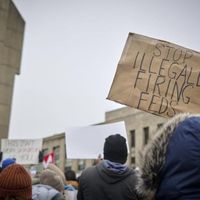In a significant ruling, a federal judge has ordered the Trump administration to reinstate thousands of probationary workers who were terminated in recent government cutbacks. U.S. District Court Judge William Alsup, based in California, criticized the administration for its approach of placing these workers on paid administrative leave instead of reinstating them to their original positions, as was required by his earlier injunction.
On March 17, 2025, Alsup mandated that the affected employees should be restored to their roles promptly, highlighting the inefficacy of the administration's method. "The Court has read news reports that, in at least one agency, probationary employees are being rehired but then placed on administrative leave en masse. This is not allowed by the preliminary injunction, for it would not restore the services the preliminary injunction intends to restore," he stated in his order.
Following sweeping cuts implemented by the Trump administration, tens of thousands of probationary federal workers were dismissed last month. According to recent counts, nearly 25,000 of these employees, many of whom had demonstrated commendable performance records, are entitled to reinstatement under the court's rulings, which deemed their dismissals unlawful.
The administration has justified its actions, claiming that placing these workers on leave is a necessary interim step as they navigate the reinstatement process. However, this approach has sparked outcry among labor unions and advocates, who argue that such measures merely skirt the court's demands.
As highlighted in the filings by various federal agencies, many workers who were ordered to be reinstated have been placed in a "leave status," receiving pay but not returning to work. Reports reveal that employees from the Environmental Protection Agency and the Department of Commerce find themselves in administrative leave positions, where they are essentially sidelined from their job duties.
The judge's directive came as part of a broader legal challenge against the administration's mass layoffs, particularly as the Office of Personnel Management had previously facilitated the firings. Proponents of the terminated employees, including the American Federation of Government Employees and other unions, argued that legal procedures regarding federal layoffs had been violated. The unions assert that the administration’s mass firings circumvented established Congressional powers and failed to account for the procedures mandated by federal law.
"This is not a simple matter. We're talking about lives, families, and livelihoods affected by unjust terminations," remarked a representative from the American Federation of Government Employees in response to the controversy.
The context of these layoffs and reinstatements hinges on the precarious status of probationary federal employees—those typically in their first or second year of service. While lacking some of the permanent protections afforded to tenured federal workers, they can only be let go for just cause. Many of those who were terminated claimed to have received no individual assessments or warnings prior to their dismissal, suggesting a broader misuse of the probationary firing process for mass layoffs.
Despite the judge's clear instructions, the Trump administration expressed concerns that reinstating workers could create "significant confusion" and turmoil within the workplace. In their filings, they outlined the significant logistical burdens of re-hiring former workers, who would need to undergo onboarding once again, including training, paperwork, and security clearances. Yet, many impacted workers have grown increasingly anxious as they remain unsure of their job statuses.
As noted in various agency communications following the judge's order, the Transportation Department has taken a notably different approach. It announced plans to bring its 757 affected employees back to active duty by March 20, 2025, presuming they do not resign. Meanwhile, other departments, such as Energy and Agriculture, reported ongoing efforts to comply with the judge’s mandate, though no clear timelines were established for returning their employees to work.
Judge Alsup has required updates by March 18, 2025, on the status of the affected employees, holding agencies accountable for their actions. This showcases the ongoing tensions between the judicial and executive branches concerning federal employment practices and raises critical questions about accountability in public service.
The ruling also underscores the fragility of workers' rights in the context of shifting political landscapes, with many employees relying on the legal system to safeguard their rights. The current situation serves as a reminder that the integrity of public service employment hinges on transparent and fair processes, and not merely on administrative maneuvering.
As federal agencies sift through the complexities of reinstating thousands who were dismissed in a mass action, the implications of the judge’s rulings will have lasting effects not only on the reinstated employees but also on the broader federal workforce landscape. The situation continues to evolve, illuminating the significant challenges that lie ahead as the government works to restore order amidst ongoing legal scrutiny.






